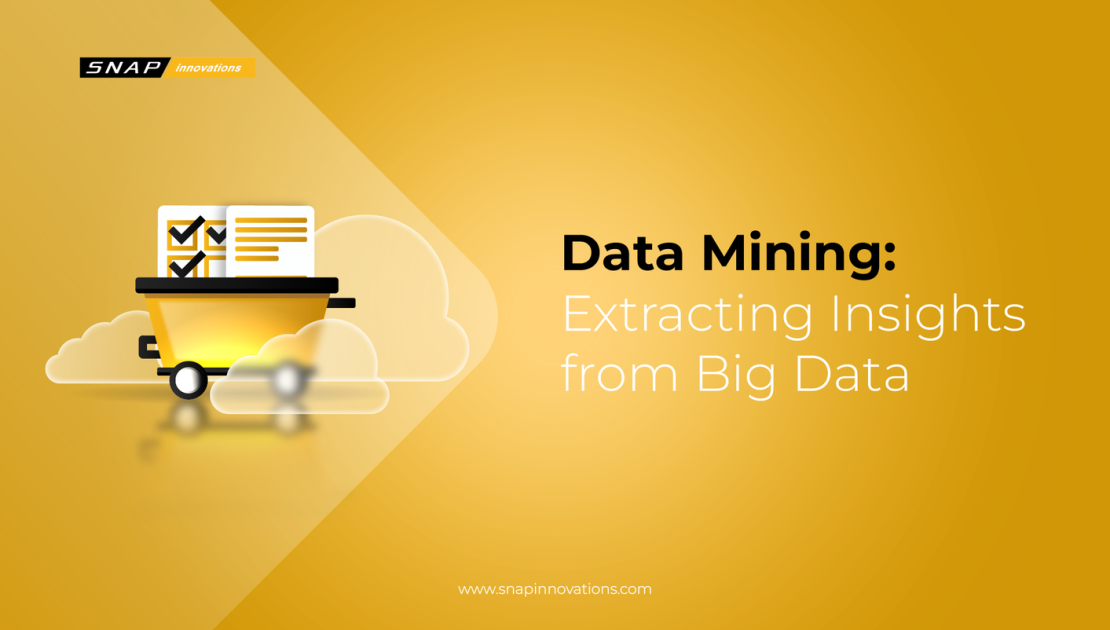In the digital age, data has become one of the most valuable resources, and organizations are sitting on mountains of it. But how can they extract meaningful insights and patterns from this sea of information? The answer lies in data mining, a powerful technique that enables us to dig deep into vast datasets and unearth valuable knowledge.
In this article, we will explore the realm of data mining, understanding what it is, how it works, and its significance in the era of Big Data.
What is Data Mining?
 At its core, data mining is the process of discovering hidden patterns, trends, and knowledge within large datasets. In today’s data-driven world, organizations and individuals are inundated with vast amounts of information. This data can come from a multitude of sources, including customer interactions, online behavior, sensor data, and more. While this data is abundant, it is often unstructured and overwhelming to process manually. This is where data mining steps in as a powerful solution.
At its core, data mining is the process of discovering hidden patterns, trends, and knowledge within large datasets. In today’s data-driven world, organizations and individuals are inundated with vast amounts of information. This data can come from a multitude of sources, including customer interactions, online behavior, sensor data, and more. While this data is abundant, it is often unstructured and overwhelming to process manually. This is where data mining steps in as a powerful solution.
Data mining involves the use of various techniques, including statistical analysis, machine learning, and artificial intelligence, to extract valuable information from structured and unstructured data. Imagine data mining as a digital treasure hunt, where skilled analysts are equipped with sophisticated tools to explore the data landscape in search of nuggets of wisdom.
The process typically begins with data collection, where relevant data is gathered from various sources. This raw data is then preprocessed to clean and organize it, making it suitable for analysis. Data preprocessing is a critical step because the quality and cleanliness of the data directly impact the accuracy of the results.
How Does Data Mining Work?
 Data mining involves several steps, beginning with data collection and preprocessing. Once the data is cleaned and organized, the next step is to select appropriate data mining techniques.
Data mining involves several steps, beginning with data collection and preprocessing. Once the data is cleaned and organized, the next step is to select appropriate data mining techniques.
1. Data Collection
Data mining initiates with the extensive collection of data from a multitude of sources. These sources may encompass structured databases, unstructured text documents, web content, sensor data, social media interactions, and more. The quality and quantity of data amassed are pivotal determinants of the success of data mining endeavors. It’s imperative to cast a wide net and gather data from diverse sources to maximize the potential for valuable insights.
In this phase, data is not only collected but also cleaned and prepared for subsequent analysis. Data can be acquired through surveys, automated sensors, web scraping, or other data-generating mechanisms. The larger and more diverse the dataset, the greater the scope for discovering valuable patterns and correlations.
2. Data Preprocessing
Data collected from various sources often requires preprocessing to ensure its quality and suitability for analysis. This step entails data cleaning, transformation, and reduction. Noisy data, which includes outliers and errors, needs to be identified and rectified. Missing values may be imputed through various techniques such as mean substitution or interpolation. Data transformation involves converting data into a suitable format and scaling variables to ensure comparability.
Additionally, data reduction techniques like dimensionality reduction can be applied to simplify complex datasets. Data preprocessing is crucial for ensuring that the data is accurate, relevant, and conducive to meaningful analysis. For instance, in financial data mining, missing stock price values might be filled using interpolation techniques to maintain data integrity.
Also Read: Margin Trading: Strategies for Maximizing Profits
3. Selection of Data Mining Techniques
Data mining encompasses a vast array of techniques and algorithms, each suited for specific tasks and objectives. Analysts must discern the overarching goal of the analysis, whether it’s classification, clustering, regression, anomaly detection, or some other objective. Based on this determination, they select the appropriate algorithms and models to apply to the prepared data.
For instance, in healthcare data mining, decision trees might be chosen to predict patient outcomes based on medical history. Similarly, in fraud detection, a combination of techniques such as clustering and neural networks might be employed to identify unusual patterns in financial transactions.
4. Pattern Discovery
At the core of data mining lies the process of pattern discovery. Algorithms are applied to the prepared data to unearth hidden patterns, relationships, or trends. Common techniques include association rule mining, which identifies item sets that frequently occur together, and clustering, which groups similar data points together.
Machine learning algorithms, such as decision trees or neural networks, are often leveraged for pattern discovery. In marketing data mining, for instance, these patterns might reveal insights into customer behavior, such as purchasing habits or responses to marketing campaigns.
5. Pattern Evaluation
Identifying patterns is just the first step; they must also be assessed for their significance and usefulness. Analysts evaluate the discovered patterns against predefined criteria to determine their relevance to the specific problem or question being addressed.
This step helps filter out less valuable patterns and prioritize those that are meaningful and actionable. For example, in fraud detection, unusual patterns in financial transactions may be flagged for further investigation, while those that align with expected behavior are considered routine.
6. Knowledge Representation
The insights gleaned through data mining need to be presented in a comprehensible and actionable manner. Visualization tools and techniques are frequently employed to create informative charts, graphs, and reports.
These visual representations of data mining results facilitate decision-making and enable effective communication of findings to stakeholders. In e-commerce, for instance, data mining insights may be visualized through customer segmentation heatmaps, helping guide marketing campaigns by highlighting customer preferences and behaviors.
7. Deployment
The knowledge derived from data mining is not merely theoretical; it is meant to be put into practical use. Depending on the application, this can involve implementing recommendations, making predictions, or optimizing processes.
In a business context, data mining insights may lead to changes in marketing strategies, product recommendations, or supply chain optimization. In the energy sector, data mining can optimize power grid operations based on consumption patterns, enhancing efficiency and resource allocation.
8. Monitoring and Maintenance
Data mining is an iterative process that continues even after deployment. It is imperative to monitor the performance of models, patterns, and algorithms over time. As new data becomes available, models may need to be updated, refined, or adapted to evolving circumstances. Regular maintenance ensures that the insights derived from data mining remain relevant and effective.
Continuous improvement is essential to keep up with changing market conditions, consumer behavior, and technological advancements. In the realm of stock market data mining, for example, models must be continually adjusted to reflect the latest market dynamics and economic indicators.
Data mining is a dynamic and evolving field, continuously benefiting from technological advancements and the increasing availability of data. It empowers businesses, researchers, and decision-makers to leverage data-driven insights for improved outcomes and a deeper understanding of the world around us. Whether in finance, healthcare, marketing, or other domains, data mining plays a pivotal role in uncovering hidden knowledge, facilitating data-driven decisions, and driving innovation.
The Significance of Data Mining
 The significance of data mining in today’s data-driven world cannot be overstated. It serves as a powerful tool that helps organizations extract actionable insights from vast and complex datasets, illuminating hidden patterns, trends, and knowledge. In business, data mining is the backbone of customer relationship management, enabling companies to tailor their products and marketing strategies to meet individual customer needs and preferences. It also plays a crucial role in fraud detection, identifying unusual patterns in financial transactions that may indicate fraudulent activities.
The significance of data mining in today’s data-driven world cannot be overstated. It serves as a powerful tool that helps organizations extract actionable insights from vast and complex datasets, illuminating hidden patterns, trends, and knowledge. In business, data mining is the backbone of customer relationship management, enabling companies to tailor their products and marketing strategies to meet individual customer needs and preferences. It also plays a crucial role in fraud detection, identifying unusual patterns in financial transactions that may indicate fraudulent activities.
In healthcare, data mining aids in patient diagnosis and treatment recommendations by analyzing medical records and identifying potential risk factors. It has been instrumental in disease surveillance and epidemiology, helping public health officials monitor and respond to outbreaks. For scientific research, data mining plays a pivotal role in fields like genomics and astronomy, where it helps scientists uncover new discoveries and understand complex phenomena. In genomics, it assists in identifying genetic markers associated with diseases and in the development of personalized medicine.
Moreover, in the age of big data, data mining empowers decision-makers across various sectors to make informed choices, optimize processes, and stay ahead in an increasingly competitive landscape. Its applications are diverse and far-reaching, making it an indispensable tool for organizations striving to harness the full potential of their data resources. Whether it’s enhancing customer experiences, improving healthcare outcomes, advancing scientific knowledge, or driving business growth, data mining continues to be a driving force in the modern world.
Techniques in Data Mining
Data mining encompasses a wide array of techniques and methods. Let’s dive deeper into each of these data mining techniques, exploring their applications and considerations in more detail:
1. Classification
Classification is a foundational data mining technique used extensively in various domains. In healthcare, it plays a critical role in medical diagnosis, such as identifying different types of cancer based on patient data, predicting disease outcomes, and assisting in treatment planning. In finance, classification helps banks and financial institutions assess credit risk, detect fraudulent transactions, and categorize customers for targeted marketing.
Additionally, in natural language processing, it aids in sentiment analysis, where it determines the sentiment or emotion expressed in text data, enabling businesses to gauge public opinion about products and services.
2. Clustering
Clustering is a versatile technique with widespread applications. In customer segmentation, businesses use clustering to group customers with similar preferences, behaviors, or purchase histories. This allows companies to tailor marketing strategies and product recommendations more effectively.
In biology, clustering is employed in genomics to identify genes with similar expression patterns, helping researchers understand gene functions and genetic relationships. Geospatial analysis also benefits from clustering, assisting urban planners in identifying areas with similar characteristics, which is crucial for city development and resource allocation.
3. Regression Analysis
Regression analysis is a statistical technique used to model relationships between variables. In economics, economists rely on regression models to study the impact of various factors on economic growth, inflation, and employment.
Businesses utilize regression analysis for sales forecasting, pricing optimization, and marketing spend allocation. This technique not only predicts outcomes but also quantifies the strength and nature of relationships, providing valuable insights for decision-making.
4. Association Rule Mining
Beyond market basket analysis, association rule mining finds applications in recommendation systems. Online retailers like Amazon use this technique to suggest products to customers based on their browsing and purchase history, enhancing the shopping experience and increasing sales.
In healthcare, association rule mining helps in discovering patterns in patient records, assisting in the identification of potential risk factors and improving treatment strategies. It’s also integral to web usage mining, where it helps website owners understand user behavior and optimize website design and content.
5. Anomaly Detection
Anomaly detection is crucial for maintaining security and quality across various domains. In cybersecurity, it is employed to identify unusual patterns or activities in network traffic, enabling organizations to detect and respond to cyberattacks promptly.
In manufacturing, it ensures product quality by detecting defects or irregularities in the production process, minimizing waste and ensuring product consistency. Anomaly detection is also instrumental in financial services for fraud detection, flagging suspicious transactions and preventing financial losses.
Also Read: Operating Margin: Strategies for Continual Improvement
6. Natural Language Processing (NLP)
The applications of NLP are extensive and continue to grow. Sentiment analysis, a part of NLP, helps brands and businesses track public sentiment about their products or services on social media, enabling them to adjust marketing strategies and respond to customer feedback effectively.
Named entity recognition, another NLP task, plays a critical role in information retrieval, where it extracts entities like names, dates, and locations from unstructured text data, making it easier to access and organise information. Topic modeling in NLP enhances content recommendation systems, tailoring content suggestions to individual preferences, thereby improving the user experience on websites and applications.
7. Time Series Analysis
Time series analysis is indispensable in various fields. In finance, investors and traders rely on it for forecasting stock prices, evaluating market trends, and managing risk. Meteorologists use time series analysis for weather forecasting, aiding governments and businesses in making informed decisions related to agriculture, transportation, and disaster preparedness.
Businesses leverage it for demand forecasting, optimizing inventory management, and allocating resources efficiently. Additionally, time series analysis is crucial in the analysis of economic data, helping economists understand and predict economic trends and fluctuations.
These data mining techniques, when strategically applied, empower organizations to extract valuable insights, make data-driven decisions, and gain a competitive edge in their respective industries. As data continues to proliferate, data mining remains a vital tool for unlocking the potential hidden within vast datasets.
The Future of Data Mining
The future of data mining is poised for even greater advancements and innovations. As data continues to proliferate at an unprecedented rate, fueled by the Internet of Things (IoT) and interconnected devices, the need for robust data mining techniques will only intensify. Machine learning and artificial intelligence will play an increasingly prominent role in data mining, enabling more automated and sophisticated analysis. This will lead to faster and more accurate insights, helping organizations make data-driven decisions in real-time. Ethical considerations and privacy concerns will also shape the future of data mining, necessitating the development of responsible and transparent practices.
In addition, data mining is expected to contribute significantly to fields like healthcare, finance, and cybersecurity, with applications ranging from predictive analytics for disease prevention to fraud detection and risk assessment. The integration of data mining with emerging technologies such as blockchain and quantum computing will open up new frontiers in data analysis and security. Moreover, data mining will become more accessible to individuals and smaller businesses, thanks to user-friendly tools and cloud-based platforms. With the convergence of data from various sources and the evolution of data mining techniques, the future holds immense potential for unlocking valuable insights and driving innovation across multiple domains.
Conclusion
In a world where data is often referred to as the new oil, data mining emerges as the refining process, turning raw data into valuable insights. It empowers businesses, researchers, and decision-makers to make informed choices, solve complex problems, and shape a better future.
With each passing day, the importance of data mining becomes more pronounced, as it becomes increasingly intertwined with our daily lives, from personalized recommendations on streaming platforms to breakthroughs in healthcare and scientific research.
.


